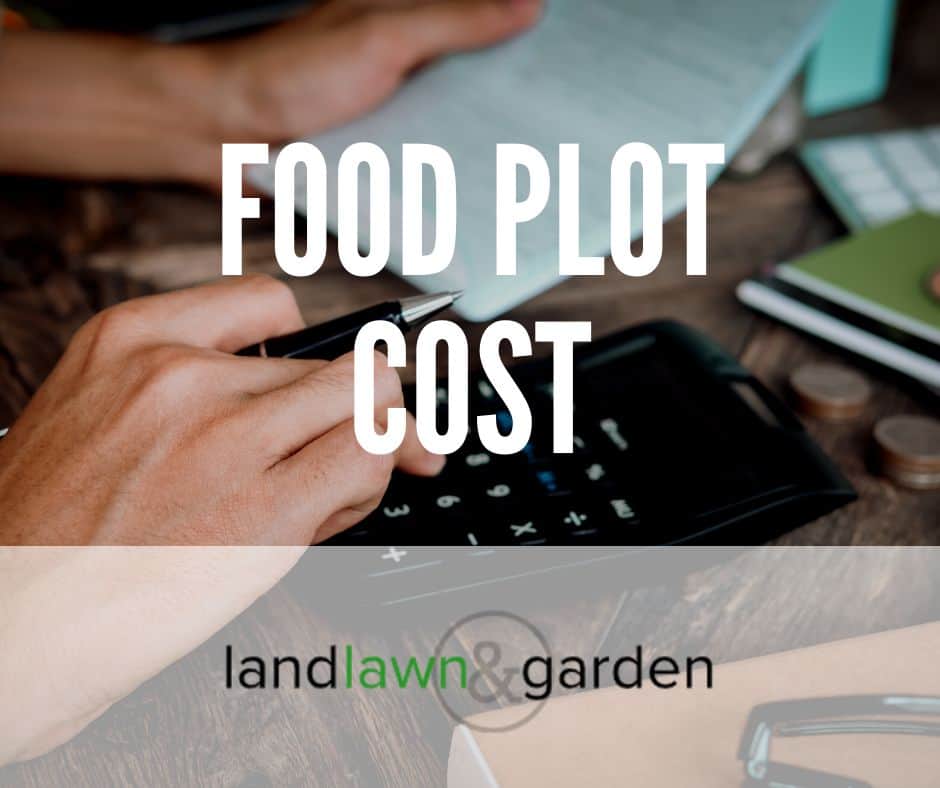The process of starting a food plot might seem like a great idea. If you create your own deer buffet in an area of your choice on your property, your chances of bagging a monster buck this hunting season are greatly improved. Your investment in establishing a food plot can pay healthy dividends and literally attract big bucks. But how much do food plots cost? Will it be worth the expense in the long run?
Here are some considerations that will affect the cost of establishing a food plot:
- The size of the plot
- The location
- Removing trees and brush
- Clearing weeds from the area
- Tilling the soil
- Adding lime to the soil
- The amount of fertilizer required
- Cost of seeds
- Fencing
While estimating the costs of setting up a food plot, remember the reward that this area will bring after all the work is done, and have fun setting it up! It may cost you a few bucks at the start, but it doesn’t have to be perfect. Deer are not fussy creatures, and it is possible to complete the project and have an impressive buck magnet area where you will enjoy reliable hunting within a few months.
Detailed Breakdown Of Costs Of A Food Plot

If you are thinking of starting a food plot from scratch, the costs will be much higher than replanting a disused field or creating a poor man’s food plot in a wooded area. Let’s go through all the costs that you will need to consider to create a food plot.
1. Size of the Plot
This initial decision will affect all the other budgetary costs—the bigger the size, the more roundup, fertilizer, fencing, and seed you will need. You can expand after your first year. While bigger is often better, if this will be your first year at starting a food plot, it may be more manageable to start with a smaller area.
The general rule is that a well-maintained food plot of one acre can support approximately 3.5 deer. The minimum size that can a food plot is ¼ acre. If you plan to go ultra-small, then aim to plant a highly attractive deer crop and keep the patch fenced until you are ready to open it. If you don’t, the plants will be decimated before they have a chance to take root.
2. The Location
Your food plot must be conveniently situated to use during hunting season while at the same time being an attractive and convenient destination for passing deer in your area. While planning your budget, remember that you will need to visit the area frequently and haul equipment to the field.
Transport is a cost that should never be underestimated when drawing up any budget because it is frequently forgotten but quickly adds up. If you have to run heavy machinery to plow or chainsaws to cut down trees, don’t forget to include the cost of getting that equipment to the selected site and using it.
For those who prefer a minimal work type of food plot that doesn’t require any heavy preparations or a lot of clearing, you could consider establishing a poor man’s food plot. This is a great project if you have a suitable area on your property and a tight budget.
3. Remove Trees And Brush
The costs incurred here will depend a lot on whether you can do the job yourself or if you need to hire heavy equipment. If you are hiring a field clearing contractor, be sure to check if the rate also includes removing all unwanted cleared vegetation.
When setting up a formal food plot, keep your final goal in mind. You will want an area where deer can feel secure stepping out and enjoying the crop, but where you will be able to remain concealed, get a clear shot. So before you start cutting trees and clearing, check what features may be useful for you when the plot is established.
If you can use any wood from felled trees as part of a hide later, it will save you money when hunting season arrives.
4. Clearing the Weeds

The process of starting a food plot is not a quick one. Whatever you plant will be smothered unless you eradicate all the weeds and existing vegetation from your plot. The size of your food plot will affect how much non-selective herbicide you will require. Roundup is a popular choice with food plot owners.
You will need 2 quarts of a glyphosate herbicide per acre. This mixed with 25 gallons of water will completely kill all the vegetation in the area, and you will be ready to move on to the next step in around two weeks. Herbicides of this sort are inexpensive, and a half-gallon bottle of Roundup concentrate will cost around $55.
5. Tilling The Food Plot
Once all the vegetation on the area has been cleared and at least two weeks have passed since you sprayed with the herbicide, you will need to plow the area. The cost will be more if you need to hire someone or have a tractor and can do it yourself, in which case your only expense would be diesel.
6. Balance the Soil’s PH Using Lime
When establishing a food plot, you will probably need to balance the PH level of your soil. You can balance the PH by applying lime in the amount of at least 1.5 tons per acre. The addition of this step will improve the yield of the plot.
Pelletized lime is relatively inexpensive and can be obtained from supply stores like Tractor Supply Co and Outdoor Warehouse. A 40-pound bag will cost around $5 but keep in mind that you will need more than a ton to make any difference on your plot. Some supply stores also rent out lime pellet spreaders to make the distribution process easier.
7. Amount Of Fertilizer Required
Unless the soil quality on your food plot is naturally outstanding, you will need to add fertilizer to produce healthy plants. If this is your first food plot, I suggest keeping the process simple and using a general 13-13-13 fertilizer that contains equal amounts of potassium, nitrogen, and phosphorus. It also does not need to be tiled into the soil so that you can save on additional labor costs.
The cost per 50-pound bag is around $24, and you will need at least 300 pounds per acre. Fertilizing is not something you can cut corners on. A great cost-cutting tip that you can use in addition to using a fertilizer of this sort is to use well-composted manure from your own or your neighbors’ farm animals. The more nourishment you can add to the soil before planting, the more prolific the growth of your plants will be.
8. The Cost Of The Seed

Besides the fertilizer you use, the seed you plant on your food plot will be your other greatest expense. If your food plot is specifically for use in the hunting season, you need to think about what will thrive and attract big buck to your plot. If you are extremely budget-conscious, clover is the food plotter’s seed of choice. Deer love it, and it grows back year after year.
When selecting a crop for the first time and especially if your food plot is small, select something that can withstand heavy browsing so that the area becomes a reliable food source for deer throughout the year. That way, you also won’t have to spend a lot on fencing to keep deer out of the area when it’s not hunting season.
Antler King is a leader in supplying seed for food plots and has various seed mixes specifically formulated for various planting conditions and desired outcomes.
Let’s have a look at the cost of some of the seed mixes and :
| Seed Mix | Area Covered | Crop Description | Cost |
|---|---|---|---|
| Honey Hole | 3 lb. bag – plants 1/2 acre | Rape and turnip fall/winter annual | $24.99 |
| Game Changer | 2.5 lb. bag – plants 1/4 acre | No till/ minimum till clover perennial/annual | $24.99 |
| Slam Dunk | 3.5 lb. bag – plants 1/4 acre | The all-fall annual – early fall (winter peas, buckwheat) – late fall (radishes, forage rape) | $24.99 |
| Trophy Clover Mix | 3.5lb bag – plants ½ acre | Clover/chicory perennial | $34.99 |
| Booner Buffet | 3 lb. Bag plants 1/4 acre | Two best multi-leaf alfalfa varieties | $34.99 |
If you are budget conscious, clover is the food plotter’s seed of choice. Deer love it, and it grows back year after year.
9. Fencing
When estimating the cost of a food plot, keep in mind that at some point, your plot maybe a little too delectable to neighborhood whitetails, and it may be before you want to open it to them. Of course, you don’t want to put in any permanent fencing, and there are quite a few DIY temp fencing options that you can try – everything from regular hazard tape to just hanging soap bars in the area to mask the smell of your delicious crop.
But if you want to budget comprehensively ahead of time, something like a P2 Plot Protector system will safeguard a one-acre area and costs $44.99.
Wrapping Up
Food plots have become a very popular tool for landowners and hunters. Improving the overall condition of the deer in your area and being able to predict their location reliably will ensure that you get your trophy and your family enjoys delicious venison for a long time to come. You can effectively budget before starting a food plot project, making the entire project more enjoyable.

Kevin is the owner of Land Lawn & Garden. In addition to taking a lot of pride in his lawn at home, he also helps manage the family land. You can find more about him here.

